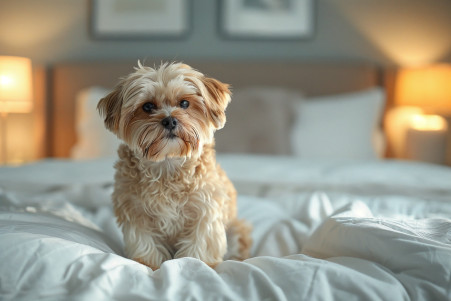How to Get Your Dog to Stop Peeing on the Bed: Expert Advice
30 March 2024 • Updated 29 March 2024

If your furry friend has been peeing on your bed, you’re probably feeling frustrated and fed up with the messes. However, the good news is that you can get your dog to stop peeing on your bed by first figuring out why they’re doing it, whether it’s a medical issue, a lack of proper house training, or anxiety, and then working to solve the problem with positive reinforcement training, environmental management, and possibly help from a vet.
In this article, we’ll cover the techniques and solutions that experts recommend, including information from professional dog trainers, veterinary behaviorists, and animal welfare organizations. We’ll also discuss the most recent studies on dog behavior and training to give you a well-rounded view of how you can deal with this unwanted behavior and get your bed back to normal (and dry).
How can I get my dog to stop peeing on the bed?
Successful Potty Training Techniques
To avoid your dog developing a habit of peeing on the bed, it’s important to have a successful potty training plan in place. According to the Humane Society, the most important thing is to be consistent. Make sure you’re taking your puppy out often, at least every two hours, and after naps, playtime, and meals. When they go to the bathroom outside, make sure to give them a treat or praise so they know that’s the behavior you’re looking for.
American Humane suggests feeding your dog on a schedule rather than free-feeding, as "eating all day = pooping all day." Stick to a feeding schedule that your vet recommends so you can also predict when your dog will need to go to the bathroom. Make sure to keep a close eye on your dog in the house and keep them out of certain areas, like the bedroom, until they are fully potty trained.
Crate training can also be helpful, as PetMD explains that dogs are less likely to go to the bathroom where they sleep. If you can’t watch your dog, make sure to put them in a crate or a small room so they don’t have the opportunity to go to the bathroom. Most importantly, make sure to be patient and consistent. Fear Free Happy Homes warns against punishing your dog for having accidents, as this can lead to fear and confusion, which will only make the training process take longer. If you’re consistent and patient, your dog will learn where and when it’s appropriate to go to the bathroom in no time.
Retraining and Positive Reinforcement Techniques
If your dog has already started peeing on the bed, it's important to retrain them using positive reinforcement techniques. According to WikiHow, the best way to do this is to have treats ready and give them to your dog as soon as they go to the bathroom in the right place. If you catch them going inside, tell them "no" in a stern voice and then take them outside. This will help them make the connection between going to the bathroom outside and getting a treat.
Potty Buddy suggests using positive reinforcement like verbal praise, petting, or treats to help solidify your dog's understanding of where you want them to go. You can also start to increase the time between bathroom breaks as they get better at holding it. Providing mental and physical exercise can also help alleviate any anxiety or boredom that may be causing the accidents, as mentioned by Wag!.
It's important to be consistent and patient when retraining your dog. Punishment should be avoided, as it can make the problem worse by causing fear and confusion. However, with a positive, reward-based method, you can help your dog overcome their habit of peeing on the bed.
Dealing With Anxiety and Marking Behavior
If your dog is peeing on your bed, it could be due to anxiety, stress, or other fear-related issues. The American Kennel Club notes that dogs that are fearful may pee on the bed because it's a "safe spot," and separation anxiety can also lead to peeing on the bed when the owner is away.
Newsweek points out that dogs can lose control of their bladders in stressful situations, such as when there are loud noises, when there are guests in the home, or when there are changes in the home. It's important to figure out what's causing your dog to be stressed and then work to eliminate or reduce the stressor.
You can help your dog feel more confident through positive reinforcement training and gradually exposing them to new situations. The Humane Society also recommends that you keep your dog's schedule as consistent as possible, intervene if your dog is feeling stressed, and reward your dog with treats when they're calm.
Making sure your dog gets enough exercise and mental stimulation can also help reduce boredom and anxiety that could lead to marking behavior. In more extreme cases, the Humane Society notes that you may want to talk to your vet about calming aids or pheromone diffusers to help your dog feel more at ease.
Once you've addressed the underlying causes of your dog's anxiety and marking behavior, you'll be well on your way to stopping your dog from peeing on your bed. In addition, as you'll learn in the next section, it's important to make sure that you thoroughly clean the areas where your dog has peed to prevent future accidents.
Effective Deep Cleaning and Deodorizing Techniques
Deep cleaning and deodorizing the mattress and sheets are necessary to keep your dog from going back to the same place. As noted by Casper, make sure to clean up any urine as soon as possible and use an enzyme-based cleaner that is specifically made to eliminate pet stains and odors. The Sleep Foundation also recommends using a vinegar, water, and baking soda solution to help get rid of the smell and remove the stain.
Mother Nature's Cleaning also recommends using baking soda to help with the smell. They suggest sprinkling it over the area, letting it sit, and then vacuuming it up to absorb any remaining odors. On the other hand, the Humane Society warns against using steam cleaners, as the heat can set the stain and odor. Instead, they recommend using an enzymatic cleaner to get rid of pet waste odors.
In addition, the Sleep Foundation also notes that using a waterproof mattress protector and washing bedding regularly can help prevent future accidents. By deep cleaning and deodorizing the affected areas, you can help ensure that your dog won’t continue to pee on your bed. If the problem persists, however, it may be time to see a vet to rule out any medical issues.
Dealing With Medical Problems and Veterinary Care
If your dog continues to pee on your bed after you have tried training and other management techniques, it is important to make sure there are no medical issues at play. As the American Kennel Club explains, urinary tract infections, kidney disease, diabetes, and other medical problems can lead to incontinence or an increase in urination. Meanwhile, the Rover.com blog notes that senior dogs can also experience incontinence due to aging or cognitive dysfunction that makes it harder for them to control their bladder.
Make sure to work with your vet to get a full checkup, as suggested by The Spruce Pets. In some cases, you may need to use medication or other interventions to deal with the medical issue at hand, according to PetMD. However, by making sure that there are no medical issues, you can make sure that you are on the right track to dealing with your dog's behavior and getting your home back to normal.
Conclusion: Bringing Back Peace and Dry Sheets
Dealing with a dog that pees on the bed will take time, patience, and a multifaceted approach. First, make sure you understand and deal with the root causes, whether they are medical, behavioral, or a combination of the two. Then, make sure you are using the right techniques to retrain your dog, including house training and positive reinforcement. Finally, help your dog deal with anxiety and marking by building confidence and managing their environment.
Don't forget to clean and deodorize the affected areas and invest in waterproof mattress protectors to prevent future incidents. By taking a comprehensive approach and making sure you are dealing with the underlying causes, you can bring back peace and dry sheets to your bed.


